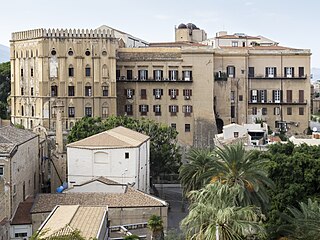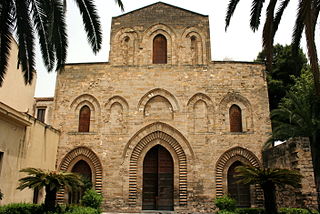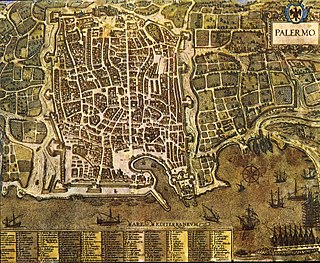
Sicily, officially Sicilian Region, is an island in the central Mediterranean Sea, south of the Italian Peninsula in continental Europe and is one of the 20 regions of Italy. With 4.8 million inhabitants, including 1.3 million in and around the capital city of Palermo, it is the most populous island in the Mediterranean Sea. It is named after the Sicels, who inhabited the eastern part of the island during the Iron Age. Sicily has a rich and unique culture in arts, music, literature, cuisine, and architecture. Its most prominent landmark is Mount Etna, the tallest active volcano in Europe, and one of the most active in the world, currently 3,357 m (11,014 ft) high. The island has a typical Mediterranean climate. It is separated from Calabria by the Strait of Messina. It is one of the five Italian autonomous regions and is generally considered part of Southern Italy.

Palermo is a city in southern Italy, the capital of both the autonomous region of Sicily and the Metropolitan City of Palermo, the city's surrounding metropolitan province. The city is noted for its history, culture, architecture and gastronomy, playing an important role throughout much of its existence; it is over 2,700 years old. Palermo is in the northwest of the island of Sicily, by the Gulf of Palermo in the Tyrrhenian Sea.

Monreale is a town and comune in the Metropolitan City of Palermo, in Sicily, Southern Italy. It is located on the slope of Monte Caputo, overlooking the very fertile valley called "La Conca d'oro", a production area of orange, olive and almond trees, the produce of which is exported in large quantities. The town, which has a population of approximately 39,000, is about 7 kilometres inland (south) of Palermo, the regional capital.

Roger II or Roger the Great was King of Sicily and Africa, son of Roger I of Sicily and successor to his brother Simon. He began his rule as Count of Sicily in 1105, became Duke of Apulia and Calabria in 1127, then King of Sicily in 1130 and King of Africa in 1148.

The Palazzo dei Normanni is also called Royal Palace of Palermo. It was the seat of the Kings of Sicily with the Hauteville dynasty and served afterwards as the main seat of power for the subsequent rulers of Sicily. Since 1946 it has been the seat of the Sicilian Regional Assembly. The building is the oldest royal residence in Europe; and was the private residence of the rulers of the Kingdom of Sicily and the imperial seat of Frederick II and Conrad IV.

The island of Sicily was under Islamic rule from the late ninth to late eleventh centuries. It became a prosperous and influential commercial power in the Mediterranean, with its capital of Palermo serving as a major cultural and political center of the Muslim world.

The Palatine Chapel is the royal chapel of the Norman Palace in Palermo, Sicily. This building is a mixture of Byzantine, Norman and Fatimid architectural styles, showing the tricultural state of Sicily during the 12th century after Roger I and Robert Guiscard conquered the island.

George of Antioch was a court official and military officer in the Norman Kingdom of Sicily that played a significant role in the transformation of Norman Sicily into a multicultural society and naval power. He did so as chiefly as an advisor to Roger II of Sicily. He was a Greek Eastern Orthodox Christian from the Byzantine Empire. George lived in Antioch for a part of his life before he and his family found work with the Byzantine Emperor Alexios Komnenos until their exile from the Empire. He and his family then worked for the Emir of Ifriqiya, Tamim ibn al-Muizz, becoming governor of the city of Sousse. After the death of George's brother at the hands of Tamim's successor, Yahya, George fled the court and found refuge in Norman Sicily. There he spent the remainder of his life, serving as both an administrator and military commander with profound influence within the Kingdom of Sicily until his death.

The Church of St. Mary of the Admiral, also called Martorana, is the seat of the Parish of San Nicolò dei Greci, overlooking the Piazza Bellini, next to the Norman church of San Cataldo and facing the Baroque church of Santa Caterina, in Palermo, Italy.
St. Nicodemus of Palermo was a Sicilian Eastern Orthodox bishop at a time when Sicily was under Muslim rule.
Siculo-Arabic or Sicilian Arabic is the term used for varieties of Arabic that were spoken in the Emirate of Sicily from the 9th century, persisting under the subsequent Norman rule until the 13th century. It was derived from Arabic following the Abbasid conquest of Sicily in the 9th century and gradually marginalized following the Norman conquest in the 11th century.

The Norman conquest of southern Italy lasted from 999 to 1194, involving many battles and independent conquerors.

The Cathedral of Cefalù is a Roman Catholic basilica in Cefalù, Sicily. It is one of nine structures included in the UNESCO World Heritage Site known as Arab-Norman Palermo and the Cathedral Churches of Cefalù and Monreale.

San Giovanni degli Eremiti is an ancient former monastic church located on Via Benedettini #19 in the ancient quarter of Albergaria of the city of Palermo, region of Sicily, Italy. It is about two blocks south from the Palazzo dei Normanni, adjacent to the church of San Giorgio in Kemonia. While the interior is virtually devoid of decoration or furnishings, the red Norman-Byzantine domes, the medieval cloister ruins, and garden make this small church a symbol of ancient Palermo.

The term Norman–Arab–Byzantine culture, Norman–Sicilian culture or, less inclusively, Norman–Arab culture, refers to the interaction of the Norman, Byzantine Greek, Latin, and Arab cultures following the Norman conquest of the former Emirate of Sicily and North Africa from 1061 to around 1250. The civilization resulted from numerous exchanges in the cultural and scientific fields, based on the tolerance shown by the Normans towards the Latin- and Greek-speaking Christian populations and the former Arab Muslim settlers. As a result, Sicily under the Normans became a crossroad for the interaction between the Norman and Latin Catholic, Byzantine–Orthodox, and Arab–Islamic cultures.

La Magione is a 12th-century Norman-Gothic architecture, Roman Catholic Basilica church, located on Via Magione #44, the entrance to the facade, which faces southeast, is through a garden path midway between via Castrofilippo and Via Giuseppe Garibaldi, in the ancient quarter of Kalsa of Palermo, region of Sicily, Italy. The apse of the church is on the southeast corner of Piazza Magione.

The Admiral's Bridge is a medieval bridge of Palermo, located in Piazza Scaffa. It was built over the Oreto River during the era of the Norman Sicily by the ammiratus ammiratorum George of Antioch. In 2015, it became a UNESCO World Heritage Site as part of a series of nine civil and religious structures inscribed as Arab-Norman Palermo and the Cathedral Churches of Cefalù and Monreale.

The Cassaro is the most ancient street of Palermo. From the late 16th century the street also had the name Via Toledo. Following the unification of Italy, it was officially renamed Via Vittorio Emanuele II, but the old and distinctive name is still in use. The street is rooted in the age of the foundation of Palermo by the Phoenicians. It provides access to a number of important sights, including the Royal Palace and the Cathedral, two UNESCO World Heritage Sites.

The Maredolce Castle, also called Favara Palace, is a medieval building of Palermo. During the Siculo-Norman age it represented one of the "Solatii Regii", pleasure palaces, of the Kings of Sicily. It is located within Favara Park, in the neighbourhood of Brancaccio.

San Giorgio in Kemonia, some decades ago renamed as San Giuseppe Cafasso, is a Roman Catholic parish church located on Via dei Benedettini #13 in the city of Palermo, region of Sicily, Italy. In 1953, the church was rededicated to Joseph Cafasso (1811-1860), patron saint of prisoners, due to former nearby female prison. The apse of the ancient church of San Giovanni degli Eremiti ends on the right flank of the church. Across the street are a series of building forming the Giovanni di Cristina Children's Hospital.

















